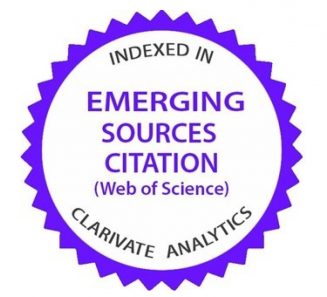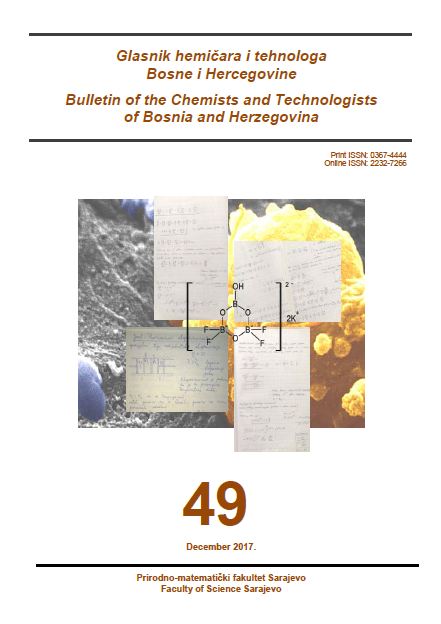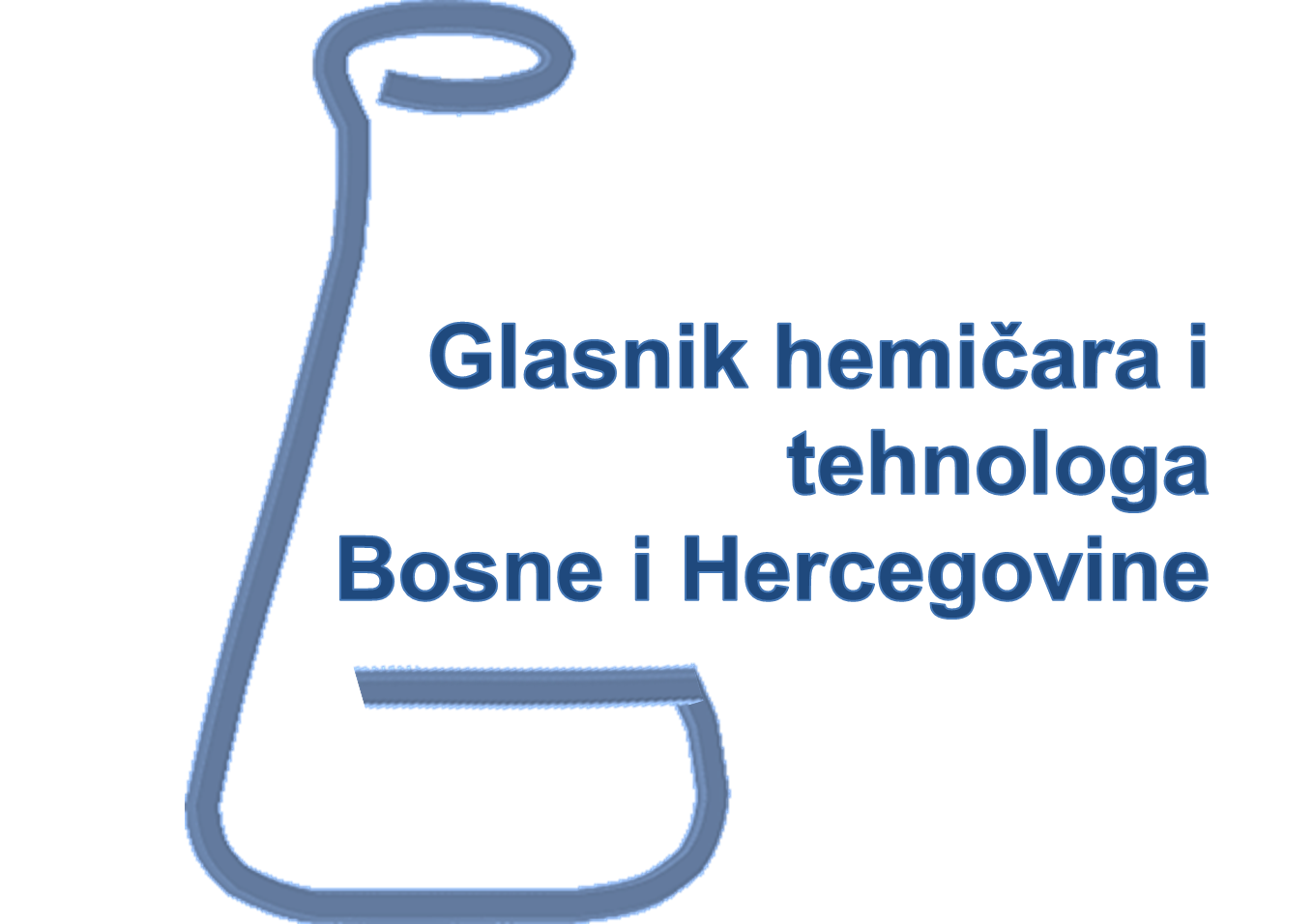|
|
Bulletin of the Chemists and Technologists of Bosnia and Herzegovina
Issue 49
Publication date: December 2017 |
|
Table of contents
Phytochemical screening, quantitative determination of phenolic compounds, and antioxidative activity of Ostrya carpinifolia Original Scientific Article
Starčević Mirsada, Subašić Mirel, Pustahija Fatima
Abstract: Ostrya carpinifolia is an interesting and suitable species for reforestation and landscaping.For the first time ever, phenolic profile, antioxidative and antimicrobial activity of O. carpinifolia was done in this study. Aqueous and methanol extracts of the aerial parts were analyzed using either fast screening methods of secondary metabolites, and UV/VIS spectrophotometry for determination of polyphenolic contents and antioxidant activity (DPPH). Antimicrobial activity of methanol extracts was investigated using the disc diffusion method against a selected nine microorganisms. Phytochemical tests confirm the presence of cardiac glycosides, coumarins, emodins, flavonoids, tannins, terpenes, terpenoids and steroids, while anthocyanins, fatty acids and saponins were absent in all aqueous extracts. Leucoanthocyanins were observed only in the stem extract. Methanol extracts of leaves contain the highest level of total phenolics and flavonoids (35.574 and 30.908 mg CE g-1 DW, respectively), while the inflorescences extracts were the richest with total proanthocyanidins and phenolic acids (19.165 mg CE and 9.342 mg CAE g-1 DW, respectively). All methanol extracts showed very strong antioxidative activity, where the lowest activity was recorded for inflorescences (IC50: 0.242 mg mL-1) and the highest for stem (IC50: 0.107 mg mL-1). Analyzed extracts showed no antimicrobial activity against the test organisms. ANOVA indicated the presence of significant differences between the total phenolics and flavonoids and DPPH (p<0.05). Duncan’s test confirmed the presence of statistically significant and very high positive correlation (R=0.989) between total phenolics and phenolic acids contents. Obtained results indicate the necessity of further research of European hop-hornbeam.
Bulletin of the Chemists and Technologists of Bosnia and Herzegovina 49, 1-8.
Spatial and seasonal variation of PAHs concentration in the Spreča river Original Scientific Paper
Mujić Emir, Pita Bahto Anesa, Mahmutović Omer, Prazina Nedžad, Papić Sejfo
Abstract:The largest part of the river Spreča flows through the heavily populated region of Tuzla canton, and it is also area of mining-industrial zone. This study monitors the PAHs content, in the part of Spreča’s flow which is extremely exposed to these pollutants during the year of 2015. Content of PAHs in the river were analyzed on three locations: prior Modrac lake, in the lake and on the mouth of Spreča into river Bosna. Determination of PAHs in the water was performed by HPLC techniques - fluorescence detection, after liquid-liquid extraction. Eight PAHs, recommended by EU directive, have been analyzed: naphthalene, anthracene, fluoranthene, benzo(b)fluoranthene, benzo(k)fluoranthene, benzo(a)pyrene, indeno(1,2,3-cd)pyrene and benzo(ghi)perylene. The highest concentration was found for naphthalene. Except naphthalene, concentration of all other PAHs was significantly higher on the mouth of Spreča than on the two previous locations. Concentration of all PAHs significantly varies during seasons and it was highest during the winter period. High level of naphthalene and fluoranthene comes from coal-mining area which is prior to Modrac lake and also from the soda drinks chemical industry further away fromthe lake. Other six PAHs mainly come from soda drimks -chemical industry.
Bulletin of the Chemists and Technologists of Bosnia and Herzegovina 49, 9-14.
Antioxidant activity of fruits and vegetables commonly used in everyday diet in Bosnia and Herzegovina Original Scientific Paper
Bulletin of the Chemists and Technologists of Bosnia and Herzegovina 49, 15-18.
Impact of the use of alternative fuels in cement production on emission of harmful pollutantsOriginal Scientific Paper
Iličković Zoran, Zilić Fehim, Sadadinović Jasminka, Andrejaš Franc, Begić Sabina
Abstract: Cement industry is a huge energy consumer, and at the same time a huge greenhouse gases generator – approx. 7% seven percent of the total global CO2 emission in 2010 (Deja, Uliasz-Bochenczyk and Mokrzycki, 2010). High fuel consumption weakens the economy of the process and the acceptance of cement’s market price, so many cement companies have turned to research to use alternative fuels in production in order to reduce both the production costs and greenhouse gas emissions. However, due to the fact that this process is basically a waste incineration, the cement industry is constantly under pressure from the general public and environmental associations, so the tests are constantly being carried out to determine emissions of harmful pollutants during the use of various alternative materials in the cement production process. This paper investigates the impact of the use of some alternative fuels (scrap tires, used oils, waste from the coal industry, waste from the tanneries and leather industry, waste from oil refining – filter cake and oily wipes & rags) in an amount of 10% (energy) on emission of harmful pollutants in cement production. The results obtained by these tests show that, although there are evident differences in the content of individual pollutants for different types of alternative fuels, total emissions stays within statutory limits.
Bulletin of the Chemists and Technologists of Bosnia and Herzegovina 49, 19-24.
Determination of phenolic content and antioxidant properties of methanolic extracts from Viscum album ssp. album Beck. Original Scientific Paper
Tahirović Azra, Bašić Neđad
Abstract: Content of phenolic compounds and antioxidant properties of methanolic extracts from Viscum album ssp. album Beck. leaves and stems was determined. Mistletoe was collected from four different hosts (Betula L., Tilia cordata Mill., Robina pseudoacacia L, and Salix alba L.). Folin-Ciocalteu method, AlCl3 method, method with Arnow reagent, and acid-butanol assay were used for determination of total phenols, flavonoids, phenolic acids and proanthocyanidins respectively. Antioxidant properties of the extracts were investigated with DPPH, ABTS and FRAP method. Total phenols were in range 7.02-13.52 mg GAE/g DW, flavonoids 2.29-5.05 mg RE/g DW, phenolic acids 0.62–2.84 mg caffeic CAE/g DW and proanthocyanidins 0.63 -4.83 mg LCE/g DW. Content of flavonoids and proanthocyanidins was higher in leaves than the stems. The highest antioxidant activity in leaves (68.93-86.89 μmol Trolox equivalents/g DW) and in stems (67.28-81.72 μmol Trolox equivalents/g DW) with DPPH, ABTS and FRAP method had mistletoe collected from Robina pseudoacacia L. Also, high correlation was obtained between total phenols, phenolic acids and proanthocyanidins content and antioxidant activity.
Bulletin of the Chemists and Technologists of Bosnia and Herzegovina 49, 25-30.
Optimization of the spectroscopic method using potassium peroxymonosulfate for determination of antioxidant capacity Original Scientific Paper
Marjanović Aleksandra, Đeđibegović Jasmina, Popovac Sanida, Omeragić Elma, Korać Fehim, Čaklovica Faruk, Turalić Amila, Šober Miroslav
Abstract: In this study, we were testing possible usage of commercial tablets for dental prosthesis, containing potassium peroxymonosulfate as a reagent for determination of antioxidant capacity in vitro. Our aim was to develop fast, simple and cheap method for determination of antioxidant capacity that will be suitable for laboratories with modest resources. This method was previously proposed, but we have chosen somewhat different approach. Because of the quite narrow linear range, when ascorbic acid was used as standard, for the preparation of the calibration curve, we have used a catechin in the concentration range from 0.125 mg/mL to 12.5 mg/mL. Obtained calibration curve was linear with correlation coefficient of R2=0.992 and it was used for further determination of antioxidant capacity of selected samples. In order to test the possibility of this method for determination of antioxidant capacity of real samples, we have used five samples which antioxidant capacity was proven in previous testing with different in vitro and in vivo methods.
Bulletin of the Chemists and Technologists of Bosnia and Herzegovina 49, 31-34.
Evaluation of the antioxidant activity of ferulic, homovanillic and vanillic acids using the Briggs-Rauscher oscillating reaction method Original Scientific Paper
Aljović Ilhana, Gojak-Salimović Sabina
Abstract: In this study, the antioxidant activity of aqueous and ethanolic solutions of ferulic, homovanillic and vanillic acids were evaluated using Briggs-Rauscher oscillating reaction method. This method is based on the inhibitory effects of antioxidants on the oscillations of the Briggs-Rauscher reaction mixture. The inhibitory effect consists of an immediate quenching of oscillations, an inhibition time that depends on the amount and type of the antioxidant added, and a subsequent regeneration of oscillations. Flow oscillations in the Briggs-Rauscher reaction mixture were followed potentiometrically. In all samples, the inhibition times increased with increasing concentration and linearity was found in a wide concentration range of phenolic acid added. The antioxidant activity decreased in following order: ferulic acid > homovanillic acid > vanillic acid. It was also investigated the antioxidant activity for two-component and three-component mixtures of aqueous solutions examined phenolic acids.
Bulletin of the Chemists and Technologists of Bosnia and Herzegovina 49, 35-38
Spectrophotometric determination of Fe ions using green tea extract Original Scientific Paper
Martinović Bevanda Anita, Talić Stanislava, Ivanković Anita, Marić Lucija
Abstract: A batch spectrophotometric method for determination of Fe (II) and Fe (III) using green tea extract as reagent is proposed. The method is based on complex formation reaction between Fe and polyphenol compounds from green tea in buffered medium (pH = 4.8). Absorbance of Fe-polyphenol complex formed during the reaction was measured at 570 nm wavelength. The linear dynamic ranges are obtained from 1.0 × 10-5 to 5.0 × 10-4mol/L. The applicability of the proposed method was demonstrated by determination of Fe ions in pharmaceutical dosage forms, orange juice, degassed mineral water and candy.
Bulletin of the Chemists and Technologists of Bosnia and Herzegovina 49, 39-42.
Chemical Characterisation of the Spring Waters used for Health Care, Guber, Srebrenica, Bosnia and Herzegovina Original Scientific Paper
Nesimović Edin, Huremović Jasna, Gojak-Salimović Sabina, Avdić Nurudin, Žero Sabina, Nesimović Edina
Abstract: The Guber spring waters in Srebrenica (Bosnia and Herzegovina) were used for centuries, and continue to be used for health-care purposes. The experts noted 48 mineral springs of different discharges and chemical composition. In this study, the physico-chemical properties, content of heavy metals and anions were determined in four selected spring waters (Mali Guber, Očna voda, Sinus voda and Ljepotica). Very low pH and very high concentrations of iron and sulphate are found in all springs. The highest concentrations of iron (2069 μg/mL) and sulphate (2486 μg/mL) and the lowest pH (1.67) were measured at spring Očna voda. The concentration of other metals and anions varied between different springs. Correlations between physico-chemical parameters and concentration of metals and anions in the water samples were also evaluated. Results for the spring water Sinus voda were evaluated for the first time.
Bulletin of the Chemists and Technologists of Bosnia and Herzegovina 49, 43-48.
Krečo Anes, Zejnilagić-Hajrić Meliha
Abstract: Astronomy, like no other scientific discipline, combines elements from almost the whole spectrum of research, from high energy physics to philosophy and psychology. It is expected that chemistry, as one of the fundamental sciences, finds significant place in this ever increasing field of frontier research. Astronomy topics in gymnasiums in Canton Sarajevo are, at present time, part of physics and geography programs. This paper explains how study of astronomy can be progressed by its incorporation in gymnasium subject such as chemistry. Topics can be chemical composition of celestial bodies, organic molecules present in gas clouds and exotic types of matter not found on Earth. The benefit of this incorporation does not hold only at purely educational level but expands on the goal of bringing somewhat abstract and fascinating ideas of reality beyond the tangible borders of Earth with the aim of increasing the interest of students in the subject of chemistry.
Bulletin of the Chemists and Technologists of Bosnia and Herzegovina 49, 49-52.




 Full version of Bulletin
Full version of Bulletin